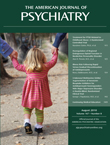To the Editor: In the March 2010 issue of the
Journal, Pierre Blier, M.D., Ph.D., et al. (
1) presented a valuable contribution to our knowledge of combination treatments for depression, especially by studying the efficacy of such combinations at treatment inception.
Nonetheless, I was disappointed in one aspect of their otherwise thorough report: emergent suicidality events totaled 12 (defined by a 1-point increase in either rating scale), surprisingly totaling more than 10% of the sample, and yet no breakdown by treatment was provided. (In contrast, for other side effects, incidence by treatment group was provided for all side effects totaling >5% in incidence). The authors stated that when a more stringent definition was used (increases in scores on both rating scales simultaneously), only three events occurred (still equaling 2.8%, which is higher than the Food and Drug Administration definition for a "frequent" adverse event). However, given that the Montgomery-Åsberg Depression Rating Scale score for suicide ranges from 0 to 6 versus the Hamilton Depression Rating Scale (HAM-D) score of 0–4, I am not sure that rater bias, as suggested by Dr. Blier et al., was necessarily the only reason for discrepancy in changes in suicide scores on these two scales.
Could the authors please provide a breakdown by treatment group for the 12 events of worsened suicidality by either scale occurring in the trial? In addition, given their complex design, which featured sudden discontinuation in some arms, gradual discontinuation in others, and no discontinuation in still others, it would be helpful if the authors could also provide counts of the events that occurred during the acute phase versus the prolongation/discontinuation phase, preferably, again, by treatment group. This is especially important because treatment discontinuation has been postulated to be a high-risk period for treatment-associated suicidality (
2,
3).
While counts by treatment and treatment phase are likely to be low (no more than 1–2 per cell) and a substantial number of these events of worsened suicidality may be attributable to worsened depression, reporting the data in this way would maximize the usefulness of these data for future researchers conducting meta-analyses and clinicians trying to better understand potential risks associated with antidepressant treatment and with depression in general. Such information would bring the reporting of worsened suicidality up to the standards of the rest of the valuable study by Dr. Blier et al.

